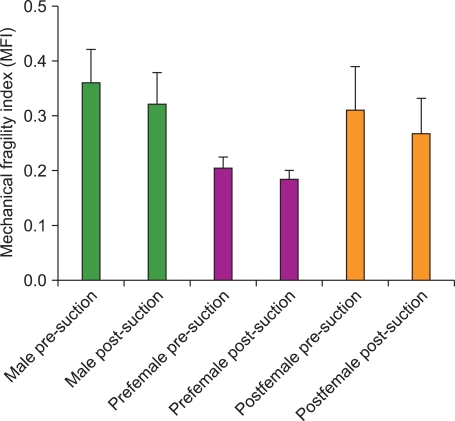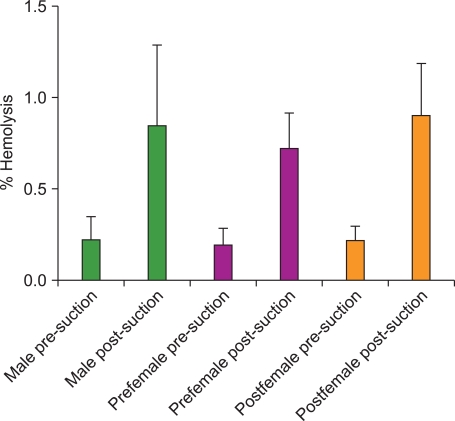Korean J Hematol.
2011 Mar;46(1):31-35. 10.5045/kjh.2011.46.1.31.
The impact of suctioning RBCs from a simulated operative site on mechanical fragility and hemolysis
- Affiliations
-
- 1Department of Pathology, University of Pittsburgh Medical Center, Pittsburgh, PA, USA.
- 2The Institute for Transfusion Medicine, Pittsburgh, PA, USA.
- 3Department of Anesthesiology, The Magee Womens Hospital of the University of Pittsburgh Medical Center, Pittsburgh, PA, USA.
- 4Department of Bioengineering, University of Pittsburgh, Pittsburgh, PA, USA.
- 5McGowan Institute for Regenerative Medicine, University of Pittsburgh, Pittsburgh, PA, USA.
- KMID: 2252016
- DOI: http://doi.org/10.5045/kjh.2011.46.1.31
Abstract
- BACKGROUND
Intraoperative cell salvage exerts shear stress upon RBCs, particularly as they are suctioned from the surgical field. Shear stress can result in overt hemolysis or it can cause sublethal injury to the suctioned RBCs. The mechanical fragility (MF) test uses shear stress to measure the extent of RBC sublethal injury. RBCs that have sustained sublethal injury are more susceptible to shear stress induced hemolysis. In this study we suctioned whole blood samples from an artificial surgical field to determine if pre-menopausal female RBCs would demonstrate greater resistance to hemolysis and less sublethal injury compared to that of males and post-menopausal females.
METHODS
Ten CPD-preserved whole blood units from these 3 donor groups were obtained and samples suctioned at -150 mmHg from a simulated surgical field. The MF test was then performed and the % hemolysis calculated. In addition the MF test was serially performed on these whole blood units during the 21 days of storage.
RESULTS
There were no differences in the extent of hemolysis or RBC shear stress resistance after suctioning between the 3 donor groups. During storage the pre-menopausal female RBCs demonstrated higher shear stress tolerance compared to the males or post-menopausal females at all of the time points.
CONCLUSION
Although during static storage pre-menopausal female RBCs in CPD-preserved whole blood demonstrated higher shear stress tolerance, this enhanced resistance was not observed after suctioning from a simulated surgical field.
Keyword
Figure
Reference
-
1. Gregoretti S. Suction-induced hemolysis at various vacuum pressures: implications for intraoperative blood salvage. Transfusion. 1996; 36:57–60. PMID: 8607155.
Article2. Waters JH, Williams B, Yazer MH, Kameneva MV. Modification of suction-induced hemolysis during cell salvage. Anesth Analg. 2007; 104:684–687. PMID: 17312230.
Article3. Waters JH, Lee JS, Karafa MT. A mathematical model of cell salvage efficiency. Anesth Analg. 2002; 95:1312–1317. PMID: 12401618.
Article4. Raval JS, Waters JH, Seltsam A, et al. The use of the mechanical fragility test in evaluating sublethal RBC injury during storage. Vox Sang. 2010; 99:325–331. PMID: 20673245.
Article5. Raval JS, Waters JH, Seltsam A, et al. Menopausal status affects the susceptibility of stored RBCs to mechanical stress. Vox Sang. 2010; (published online http://onlinelibrary.wiley.com/doi/10.1111/j.1423-0410.2010.01439.x/full).
Article
- Full Text Links
- Actions
-
Cited
- CITED
-
- Close
- Share
- Similar articles
-
- The Extended Preservation of Outdated Red Blood Cells with Rejuvesol and Additive Solutions
- The Preparation of Frozen Red Blood Cells and Deglycerolization of Frozen RBCs with Haemonetics V50plus
- Hemolysis of irradiated leukoreduced red blood cells during rapid warming: An in vitro experimental study
- The Preparation of Frozen Red Blood Cells and a Procedure for Deglycerolizing Frozen RBCs using COBE 2991 Blood Cell Processor
- Effects of Open or Closed Suctioning on Lung Dynamics and Hypoxemia in Mechanically Ventilated Patients





